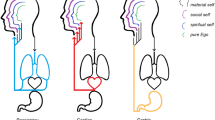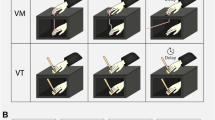Abstract
In phenomenology the body is often referred to as the lived body which makes the world familiar to me. In this paper, however, I discuss bodily self-consciousness in terms of self-distance. Self-distance is the suggestion that bodily self-consciousness consist in a reflective stance where you conceive of your body as a physical thing, an object in the world as well as the subject of bodily experiences. I argue that we are bodily self-conscious because we experience our own body in more than one way and that these ways are not derivative of one another or hierarchically ordered. This latter claim conflicts with certain phenomenological readings of how the body is experienced, one of which I will refer to and discuss as the Familiarity Objection to my idea of self-distance. I end the paper with a discussion of why we need the conception of experienced objectification that is entailed in the notion of self-distance to account for both pathological and non-pathological bodily self-experiences. The notion of self-distance improves our understanding of how the body plays a central role in psychosis for the experience of distorted inter-subjective relations.
Similar content being viewed by others
References
Burwood, S. (2008). “The Apparent Truth of Dualism and the Uncanny Body” in Phenomenology and the Cognitive Sciences, 7 (2), 263–278.
Cole, J., & Spalding, H. (2009). The Invisible Smile. Living Without Facial Expression. Oxford: Oxford University Press.
de Haan, S., & Fuchs, T. (2010). The ghost in the machine: Disembodiement in schizophrenia—Two case studies. Psychopathology, 43, 327–333.
Fuchs, T. (2005a). “Delusional mood and delusional perception—A phenomenological analysis”. Psychopathology, 38, 133–139.
Fuchs, T. (2005b). “Corporealized and disembodied minds. A phenomenological view of the body in melancholia and schizophrenia”. Philosophy, Psychiartry and Psychology, 12(2), 95–107.
Gaebel, W., & Wölwer, W. (2004). Facial expressivity in the course of schizophrenia and depression. European Archives of Psychiatry and Clinical Neuroscience, 254, 335–342.
Honneth, A. (2003). “Die Gleichursprünglichkeit von Anerkennung und Verdinglichung. Zu Sartres Theorie der Intersubjektivität” in B.N. Schumacher (Hg.): Das Sein und das Nichts. Berlin: Akademie Verlag.
Honneth, A. (2005). Verdinglichung. Eine anerkennungstheoretische Studie. Fankfurt am Main: Suhrkamp Verlag.
Honneth, A., & Margalit, A. (2001). “Recognition. Invisibility: On the epistemology of recognition”. Aristotelian Society Supplementary, 75(1), 111–126.
Husserl, E. (1952). “Ideen zu einer reinen Phänomenologie und phänomenologischen Philosophie. Zweites Buch. Phänomenologische Untersuchungen zur Konstitution” in M. Biemel (Hg.): Husserliana 4, Den Haag: Martinus Nijhoff.
Ingerslev, L. R. (2010). Expressivity and Social Experience, PhD thesis, University of Copenhagen: Faculties of Humanities, Grafisk KUA
Martin, M. (1992). “Sight and Touch”. In T. Crane (Ed.), The Contents of Experience: Essays in Perception. Cambridge: Cambridge University Press.
Merleau-Ponty, M. (1962). The Phenomenology of Perception. London: Routledge.
Nussbaum, M. C. (1995). “Objectification”. Philosophy and Public Affairs, 24(4), 249–291.
Parnas, J., & Handest, P. (2003). “Phenomenology of Anomalous Self-Experience in Early Schizophrenia”. Comprehensive Psychiatry, 44(2), 121–134. March/April.
Parnas, J., Møller, P., Kirchner, T., Thalbitzer, J., Jansson, L., Handest, P., et al. (2005). “EASE: Examination of anomalous self-experience”. Psychopathology, 38, 236–258.
Plessner, H. (2003a/1950). “Das Lächeln”. In G. Dux, et al. (Ed.), Gesammelte Schriften VII, Frankfurt am Main: Suhrkamp Verlag.
Plessner, H. (2003b/1941). “Lachen und Weinen. Eine Untersuchung der Grenzen menschlichen Verhaltens”. In G. Dux, et al. (Ed.), Gesammelte Schriften VII, Frankfurt am Main: Suhrkamp Verlag.
Plessner, H. (2003c/1928). “Die Stufen des Organischen und der Mensch”. In G. Dux, et al. (Ed.), Gesammelte Schriften IV, Frankfurt am Main: Suhrkamp Verlag.
Ratcliffe, M. (2008). “Touch and situatedness”. International Journal of Philosophical Studies, 16(3), 299–322.
Ratcliffe, M. (2009a). “Existential feeling and psychopathology”. Philosophy, Psychiatry & Psychology, 16(2), 179–194.
Ratcliffe, M. (2009b). “Belonging to the world through the feeling body”. Philosophy, Psychiatry & Psychology, 16(2), 205–211.
Sartre, J.-P. (1992). Being and Nothingness. New York: Washington Square Press.
Spaulding, S. (2010). “Embodied cognition and mindreading”. Mind and Language, 25(1), 119–140.
Stanghellini, G. (2009). “Embodiment and schizophrenia”. World Psychiatry, 8, 56–59.
Young, I. M. (1980). “Throwing like a girl: A phenomenology of feminine body comprotment, motility and spatiality”. Human Studies, 3, 137–156.
Acknowledgements
The author wishes to thank Dorothée Legrand, Dylan Trigg, Johan Gersel and two anonymous reviewers for their very helpful comments on earlier versions of the paper. Further, the author acknowledges the support by the Volkswagen Stiftung for the project “Narcissus and Echo: Self-Consciousness and the Inter-Subjective Body”.
Author information
Authors and Affiliations
Corresponding author
Rights and permissions
About this article
Cite this article
Ingerslev, L.R. My body as an object: self-distance and social experience. Phenom Cogn Sci 12, 163–178 (2013). https://doi.org/10.1007/s11097-011-9228-9
Published:
Issue Date:
DOI: https://doi.org/10.1007/s11097-011-9228-9




